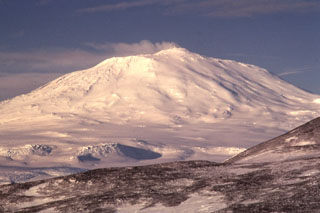Report on Erebus (Antarctica) — October 1984
Scientific Event Alert Network Bulletin, vol. 9, no. 10 (October 1984)
Managing Editor: Lindsay McClelland.
Erebus (Antarctica) Large pumiceous bombs; lava lake frozen and uplifted
Please cite this report as:
Global Volcanism Program, 1984. Report on Erebus (Antarctica) (McClelland, L., ed.). Scientific Event Alert Network Bulletin, 9:10. Smithsonian Institution. https://doi.org/10.5479/si.GVP.SEAN198410-390020
Erebus
Antarctica
77.53°S, 167.17°E; summit elev. 3794 m
All times are local (unless otherwise noted)
Vigorous explosive activity continued through the end of October. During the first half of October, there were about 15 large explosions per day, most of which were recorded by infrasonic detectors at Windless Bight and the WWSSN seismograph at Scott Base, as well as by the seismograph network on the volcano. Most explosions ejected a small number of very vesicular bombs that were typically 2-4 m in diameter but sometimes reached 6-8 m. Some of the bombs were ejected to heights of 500 m or more, possibly to as much as 1 km. Most fell on the upper 150 m of the outer crater rim. Continuous daylight in the area has prevented distant observers from seeing ejections of incandescent tephra after the early part of the increased activity.
The summit crater lava lake was ~100 m below the rim and actively convecting in late 1983. When Philip Kyle flew over the crater on 20 October, the lava lake surface had frozen and domed upward to within roughly 30 m of the rim, piling up against the N wall of the crater and sloping S. [Subsequent work has shown that the lake surface had not been domed upward. Instead, the crater had been partially filled by ejecta from the increased activity.] The bench area and fumaroles that formerly occupied the S part of the crater were covered. A small vent containing incandescent material was present near the center of the uplift and there were scattered fumaroles in the frozen lake surface. Kyle saw no explosions during his overflight but 500-1,000 bombs had accumulated on the outer crater rim in the 3-4 days since a heavy snowfall had covered earlier ejecta. Prior to the increased activity in September, few of the bombs ejected by the small Strombolian explosions that have accompanied lava lake activity since 1972 have reached the crater rim. Microprobe analyses of glass from bombs sampled by Kyle on 20 October were identical in composition to glasses in the anorthoclase phonolite bombs ejected since 1972.
Geological Summary. Mount Erebus, the world's southernmost historically active volcano, overlooks the McMurdo research station on Ross Island. It is the largest of three major volcanoes forming the crudely triangular Ross Island. The summit of the dominantly phonolitic volcano has been modified by one or two generations of caldera formation. A summit plateau at about 3,200 m elevation marks the rim of the youngest caldera, which formed during the late-Pleistocene and within which the modern cone was constructed. An elliptical 500 x 600 m wide, 110-m-deep crater truncates the summit and contains an active lava lake within a 250-m-wide, 100-m-deep inner crater; other lava lakes are sometimes present. The glacier-covered volcano was erupting when first sighted by Captain James Ross in 1841. Continuous lava-lake activity with minor explosions, punctuated by occasional larger Strombolian explosions that eject bombs onto the crater rim, has been documented since 1972, but has probably been occurring for much of the volcano's recent history.
Information Contacts: P. Kyle, New Mexico Inst. of Mining & Tech.

